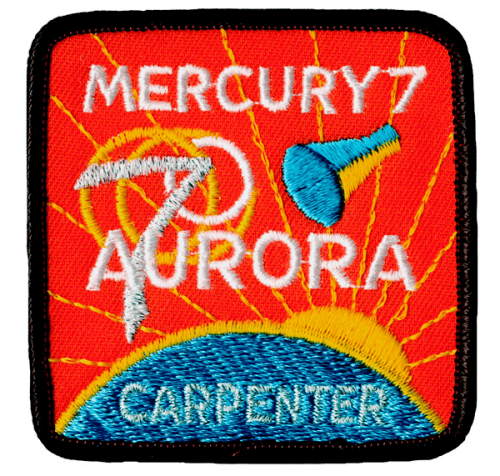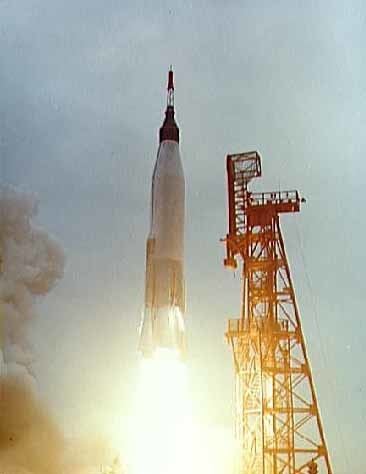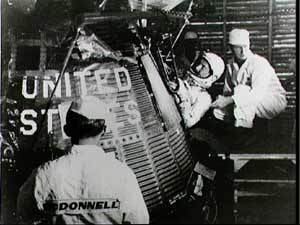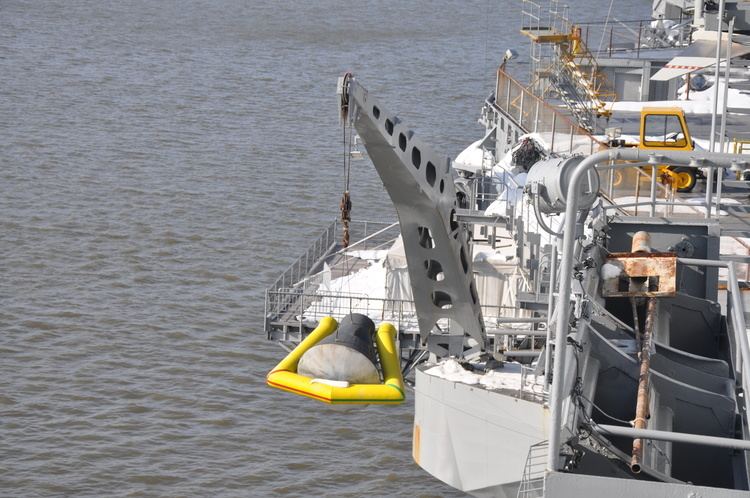Mission type Test flight SATCAT no. 295 Apogee 259,000 m Landing date 24 May 1962 | Harvard designation 1962 Tau 1 Orbits completed 3 Period 1.5 hours Launch date 24 May 1962 Date 24 May 1962 | |
 | ||
Mission duration 4 hours, 56 minutes, 5 seconds Distance travelled 122,344 kilometers (76,021 mi) | ||
Mercury-Atlas 7, launched May 24, 1962, was the fourth flight of Project Mercury, the first manned space program of the United States. The Mercury spacecraft, named Aurora 7, made three Earth orbits, piloted by astronaut Scott Carpenter. He was the sixth human and the fourth American in space.
Contents

A targeting error during reentry took the spacecraft 250 miles (about 400 km) off-course, delaying recovery of Carpenter and the spacecraft. The mission used Mercury spacecraft No. 18 and Atlas launch vehicle No. 107-D.

Crew notes

The original prime crew for Mercury Atlas-7 was to have been Deke Slayton, with Schirra as his back-up. However Slayton was removed from all flight crew availability after the discovery of cardiac arrhythmia during a training run in the g-loading centrifuge. Slayton had chosen the name Delta 7 for the spacecraft, as this would have been the fourth manned flight and Delta (Δ) is the fourth letter in the Greek alphabet. Instead of using Schirra who was backup, it was decided to give the mission to Carpenter, who was the backup crew for Mercury-Atlas 6, had trained with John Glenn, and was considered the best prepared astronaut. When Carpenter was given the mission, he renamed it Aurora 7 for the open sky and the dawn, symbolizing the dawn of the new age. The number Seven was also chosen for the Mercury 7 astronauts. In addition, Carpenter's home address in his childhood was the corner of Aurora and Seventh Avenues in Boulder, Colorado.
Mission parameters

Preparation

Mercury spacecraft No. 18 was delivered to Cape Canaveral, Florida on November 15, 1961. While under checkout, the crew changed the periscope and also worked on the drogue parachute, to prevent it from firing prematurely as happened during the previous flight. In addition, a device known as a [446] "low-level commutator" was added, to measure the temperature around the capsule, recording temperature data from 28 positions on the spacecraft.
The Atlas vehicle 107D was rolled out of the Convair factory in San Diego, California on February 25, 1962. It was delivered to Cape Canaveral on March 6, 1962.
Atlas 107D incorporated two small changes from 109D (Glenn's booster), specifically removal of an insulation blanket from the common propellant tank bulkhead that was deemed unnecessary and booster jettison changed to one second earlier (T+130 seconds instead of 131 seconds).
The temperature sensor installation and the correction of the drogue parachute circuit delayed the launch until May.
A network of ground stations and ships, called the "Mercury network" was arranged around the globe to provide continuous coverage with the spacecraft. On Mercury-Atlas 7, the network consisted of 15 Mercury sites supplemented by several Atlantic Missile Range (AMR) stations, and the Goddard Space Flight Center. CAPCOMs were operating from different stations around the world, to communicate with Carpenter. Gus Grissom was the CAPCOM in Cape Canaveral. Alan Shepard was the CAPCOM at California.
Scientific experiments
The focus of Carpenter's five-hour mission was on science. The full flight plan included the first study of liquids in weightlessness, Earth photography, and an unsuccessful attempt to observe a flare fired from the ground.
One of the experiments would include releasing a multi-colored balloon that would remain tethered to the capsule, observing the behavior of liquid in a weightless state inside a closed glass bottle, using a special light meter to determine the visibility of a ground flare, making weather photographs with hand-held cameras, and studying the airglow layer - for which Carpenter would receive special training. The tethered balloon was a 30-inch mylar inflatable sphere, which was folded, packaged, and housed with its gas expansion bottle in the antenna canister. The whole balloon package weighed two pounds. Divided into five sections of different colors - uncolored aluminum, yellow, orange, white, and a phosphorescent coating that appeared white by day and blue by night - the balloon was to be cast off near perigee after the first orbital pass to float freely at the end of a 100-foot nylon line. The purposes of the balloon experiment were to study the effects of space on the reflection properties of colored surfaces through visual observation and photographic studies and to obtain aerodynamic drag measurements by use of a strain gauge
During Flight
Carpenter was awakened at 1:15 AM on the morning of the flight and ate a breakfast of orange juice, filet mignon, eggs, toast, and coffee. Prior to insertion in the capsule, he was administered a hydration regimen of water, juice, coffee, and sweet tea. He ascended into the gantry at 4:36, and entered the spacecraft at 4:43. Unlike Mercury-Atlas 6, there was no problem with the sealing bolts.
Launch occurred at 7:45 AM (Florida time) on 24 May 1962.
Launch vehicle performance was overall excellent with one small anomaly in that one of the sustainer engine's hydraulic switches moved to the abort position at T+265 seconds, because a faulty pressure transducer produced an erroneous reading indicating loss of hydraulic pressure. However, since another transducer indicated correct pressure levels until after Sustainer Engine Cut-Off (SECO), the launch proceeded normally (both switches had to be tripped for the ASIS system to generate an abort signal). The Atlas's flight path was so accurate that Aurora 7 reached almost the exact orbital parameters planned for the mission. SECO occurred at T+309 seconds and capsule separation at T+312 seconds.
Carpenter had solid food items for the first time (in the form of freeze-dried cubes in a plastic bag) instead of paste squeezed out of a tube, which produced problems with loose crumbs floating inside the cabin. The food cubes had been coated with an anti-crumbling agent, however they may have accidentally been crushed prior to launch, breaking the coating. Carpenter expressed concern about crumbs being sucked into ventilation intakes in the capsule, in addition a candy bar included in the food supply melted from high cabin temperatures (up to 102 °F). By the end of the second orbit, he informed Mercury Control that most of the food was a mess and he would avoid touching it for the rest of the flight aside from taking a xylose capsule.
With each orbit sunrise, Carpenter also saw the "fireflies". He saw the particles more like snowflakes than fireflies. He also noted that the particles did not seem to be truly luminous, and varied in size, brightness, and color. Some were gray, some were white, and one in particular, said Carpenter, looked like a helical shaving from a lathe. Although they seemed to travel at different speeds, they did not move out and away from the spacecraft as the confetti had in the balloon experiment.
Carpenter also took 19 photos of the flattened sun at orbit sunset.
At dawn of the third and final orbit, Carpenter inadvertently bumped his hand against the inside wall of the cabin and solved a mystery from the previous flight. The resulting bright shower of particles outside the spacecraft - what John Glenn had called "fireflies" - turned out to be ice particles shaken loose from the spacecraft's exterior. Near the end of the flight, Carpenter found that by banging his hand against the wall of the capsule, he could shake more "fireflies" loose. At first, it was thought that the particles could be marker dye or shark repellant, both green-colored, however testing confirmed that neither of those were likely to escape from their packages in zero gravity.
It was then suspected that the fireflies were either steam from the life support system turning into snow when exposed to open space or debris on the exterior of the spacecraft being shaken loose, however the former was considered the more probable explanation. Steam generated by the life support system formed condensation between the spacecraft bulkhead and the heat shield which then escaped into space and froze.
Like Glenn, Carpenter circled the Earth three times. Total time weightless 4 h 39 min 32 s. The performance of the Mercury spacecraft and Atlas launch vehicle was excellent in nearly every respect. All primary mission objectives were achieved. The single mission-critical malfunction which occurred involved a failure in the spacecraft pitch horizon scanner, a component of the automatic control system. This anomaly was adequately compensated for by the pilot in subsequent in-flight operations so that the success of the mission was not compromised. A modification of the spacecraft control-system thrust units was effective. Cabin and pressure-suit temperatures were high but not intolerable. Some uncertainties in the data telemetered from the bioinstrumentation prevailed at times during the flight; however, associated information was available which indicated continued well-being of the astronaut.
Equipment was included in the spacecraft which provided valuable scientific information; notably that regarding liquid behavior in a weightless state, identification of the airglow layer observed by Astronaut Glenn, and photography of terrestrial features and meteorological phenomena. An experiment which was to provide atmospheric drag and color visibility data in space through deployment of an inflatable sphere was partially successful. The flight further qualified the Mercury spacecraft systems for manned orbital operations and provided evidence for progressing into missions of extended duration and consequently more demanding systems requirements.
Landing
Passing over Hawaii at the final orbit, Kraft told Carpenter to begin his retrofire countdown and to shift from manual control to the automatic attitude control. Partly because he had been distracted watching the fireflies Carpenter noted that he had begun his landing preparations late. As he started to align the spacecraft he found that the automatic stabilization system would not hold the required 34-degree pitch and zero-degree yaw attitude. While trying to determine the source of the trouble, he fell behind in his check of other items. When he hurriedly switched to the fly-by-wire control mode, he forgot to switch off the manual system. As a result, both systems were used redundantly together for 10 minutes, and fuel was wasted.
In addition to the attitude error, Carpenter also activated the retrorockets three seconds late, adding another 15 miles or so to the trajectory error. Due to lack of fuel Carpenter overshot his planned reentry mark and splashed down 250 miles (400 km) from target.
After several hours of frantic searching, Carpenter was located in an area northeast of Puerto Rico and taken aboard the aircraft carrier USS Intrepid. Other than slight exhaustion, he was in good health and spirits and postflight medical exams did not find any significant physical changes or anomalies.
NASA however were unhappy with the astronaut's performance due to his needlessly high expenditure of attitude control gas which resulted in reentry and landing taking place well off-course and so Carpenter was sidelined for future missions. He left the space program in 1964 to participate in the Navy's SEALAB program.
Aurora 7 is displayed at the Museum of Science and Industry in Chicago, Illinois.
